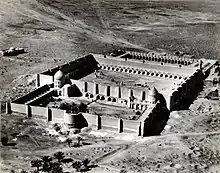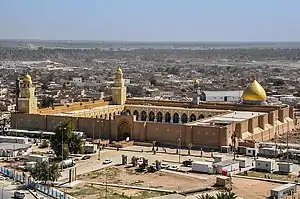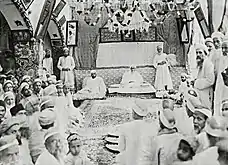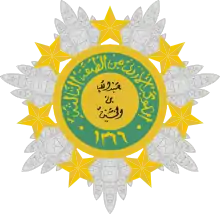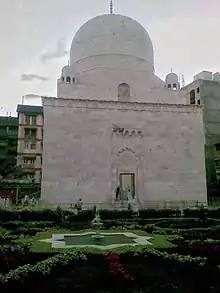Mohammed Burhanuddin
Mohammed Burhanuddin (6 March 1915 – 17 January 2014) was the 52nd Dā'ī al-Mutlaq of Dawoodi Bohras.[3] He led the community for 49 years in a period of social, economic, and educational prosperity;[4][5] substantially strengthened and re-institutionalized the fundamental core of the community's faith and emphatically revived its culture, tradition, and heritage. In successfully achieving harmonious coexistence of traditional Islamic values and modern Western practices within the community, Burhanuddin completed the work his predecessor Taher Saifuddin had started in the face of modernist onslaught.[6] Burhanuddin was presented the highest national civilian honors of the states of Egypt and Jordan[3][4] recognising his revivalism and restoration efforts.[7] He was conferred with doctorate in Islamic Sciences by Al Azhar University, doctorate in Theology by Aligarh Muslim University, and doctorate in Literature by University of Karachi.[8] He was known in Arab countries as Azamat us-Sultan (lit. 'the Great Sovereign'). Owing to extensive travels for community reachout,[2] he was the first Dā'ī al-Mutlaq to visit Europe, Australia, and America.[9]
Syedna Mohammed Burhanuddin 52nd Dā'ī al-Mutlaq of the Dawoodi Bohra | |
|---|---|
مُحـمّـد بـُرهـان الـدِّيـن | |
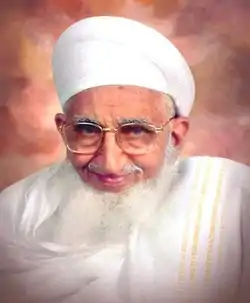 Burhanuddin c. 2010. | |
| Da'i al-Mutlaq | |
| In office 1965–2014 | |
| Preceded by | Taher Saifuddin |
| Succeeded by | Mufaddal Saifuddin |
| Title | |
| Other names |
|
| Personal | |
| Born | Mohammed 6 March 1915 |
| Died | 17 January 2014 (aged 98) |
| Resting place | Raudat Tahera, Mumbai |
| Religion | Shi'a Islam |
| Home town | Mumbai, India |
| Spouse | Amatullah Aaisaheba |
| Children | Daughters
Sons
|
| Parents |
|
| Citizenship | Indian |
| Lineage | Alid |
| Sect | Ismailism Dawoodi Bohra |
| Jurisprudence | |
| Other names |
|
| Occupation |
|
| Style | His Holiness |
| Awards | |
| Chancellor, Aligarh Muslim University | |
| In office 3 Oct 1999 – 3 Oct 2002 | |
| Preceded by | Hakim A Hameed |
| Succeeded by | Aziz M Ahmadi |
Life
Early life
Burhanuddin was born to Taher Saifuddin and Husaina Aaisaheba in Surat in the Indian state of Gujarat.[9][10]:16
Burhanuddin, taught by his father,[11] completed his religious education at the age of 13.[8] Following Burhanuddin's mīthāq (oath) in Surat, aged 15,[2]:66–67 he was appointed Amir al-Hajj (Arabic: أمِير الحَجّ, lit. 'chief of hajj pilgrims'), was conferred the title of Shaykh (Arabic: الشيخ, lit. 'leader'), and bestowed the laqab of Burhan al-Din (Arabic: بُرهان الدّيْن, lit. 'proof of faith') by his father, Taher Saifuddin.[12][13]
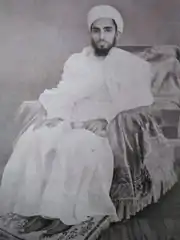
On his 17th birthday, Burhanuddin was promoted to the rank of Haddiyah (lit. 'a high rank')[14]:15 and made in charge of Alvazaratus Saifiyah, the central administrative body of the community.[14]:19 At age 19, Taher Saifuddin designated him as his successor to the office of the Dai al-Mutlaq (Arabic: داعي المطلق, lit. 'absolute missionary'), and subsequently elevated him to the station of Mazoon al-Da'wat (Arabic: مأذون الدعوة, lit. 'authorized missionary'), making him his second-in-command.[12][13] By age 20, Burhanuddin had committed the entire Quran to memory.[14]:19[15]
Marriage and family
Burhanuddin married Amatullah Aaisaheba in 1937[12] in Surat. The city and the Iwan (lit. 'hall') of Aljamea-tus-Saifiyah, the main venue of the celebrations, were decorated heavily.[16] Taher Saifuddin extended an open invitation to all community members to attend the ceremonies, and had also invited distinguished dignitaries and government officials.[17]
Burhanuddin and Amatullah had 10 children, seven sons and three daughters.[18][19]
Al-Dai al-Mutlaq
After the demise of his father, Taher Saifuddin on the 12th of November 1965, Mohammed Burhanuddin presided over a 40 day mourning period and assumed the office of his predecessor. He chose the burial place of his father to be Qasre Husaini (Raudat Tahera), the site where the shrines of Imam Ali and Imam Husain were fabricated.[2]:6[14]:25
Centenary
In 2011/1432 Hijri, Burhanuddin, celebrated his centenary in accordance with the Islamic calendar. A mega procession was organised in Mumbai that started from MG Road to Azam Campus Grounds (the route is popularly known as Marine Drive) involving 8,000 participants. Followers were dressed in golden robes traversing on horses or upon chariots. Various floats were a part of the parade displaying a variety of accomplishments during Burhanuddin’s tenure. Similar processions took place at community centers across the world.[20] During the ceremonies held over the period of a week, Burhanuddin laid the foundation stone for the SBUT project in Bhendi Bazar[21] and announced the opening of a branch of the Aljamea-tus-Saifiyah university in Nairobi, Kenya.
Appointing his successor
Burhanuddin spent a few days every year in London, where he has a home. During one such visit in 2011, he suffered a stroke and was admitted to Cromwell Hospital. Some days after being admitted to the hospital, he appointed his 2nd son, Mufaddal Saifuddin, as his successor holding a few members of his immediate family to bear witness, as per the religious traditions. He asked for the news to be communicated to all community members.[22]
Upon his return to Mumbai, Burhanuddin visited the mausoleum of his father. There, he reiterated his proclamation upon Mufaddal Saifuddin as his successor-designate amongst thousands of onlookers, the event also being broadcast to a number of other locations in Mumbai.[23]
Activities
Libas al-Anwar

Burhanuddin issued a dress code, calling for male Bohras to grow a beard and wear a white topi and kurta, and for women to wear a colorful two piece abaya, known formally as a Rida. This Islamization countered a trend toward assimilation into the larger culture of their ancestors that was also prevalent under his predecessor, Taher Saifuddin and the previous Du'at before them.[6] The history of this culture can be traced back to the medieval Fatimid dynasty in Egypt.
Al-Jame al-Anwar
In 1980 ACE/1401 AH, the Al-Hakim mosque was extensively refurbished in white marble and gold trim by Mohammed Burhanuddin. Remnants of the original decorations, including stucco carvings, timber tie-beams, and Quranic inscriptions were restored as part of the renovations. His intent to restore the ancient Al-Hakim Mosque as a place of worship in contemporary times necessitated a lighting solution that provided this important functionality to the mosque and did so in a manner that paid tribute to the Fatimid tradition of illumination and its aesthetics. The miraculous emergence of the mishkat or small lantern from the niche of the richly decorated façade of Al Jami al Aqmar provided that solution. The niche in which the lantern motif was found has also been compared to the mihrab niche of Al Azhar mosque, the same also now found in Al-Hakim mosque, which has a central motif that resembles a large lamp or lantern.[24]
Educational contributions
In October 1999, Burhanuddin was elected Chancellor of the Aligarh Muslim University,[25] a position that his father also held. He is credited with expanding the two century old Arabic university Al Jamea tus Saifiyah. In 1983, a new campus of "Al Jamea tus Saifiyah" was built by him in Karachi.[11][26] He built the "Burhaniyah Business Counseling Center" in Mumbai to provide modern business solutions.[11] He also built the Raudat Tahera, a mausoleum of his father Taher Saifuddin in Mumbai, India. It is one of a kind, having the entire Quran inscribed on its inner white walls in letters decorated with of gold leaves and with precious stones.[11][27] It was inaugurated in 1975 by the erstwhile President of India Fakhruddin Ali Ahmed.
In 1976, he established a facility exclusively dedicated to the study of arts and sciences of the Quran.[28]
MSB Schools
MSB[29] (also known as Al Madrasa Tus Saifiya Tul Burhaniyah[30][31]) was founded by Burhanuddin in 1984, with its first two branches in Mumbai, India and Nairobi, Kenya.[29] It is accredited with the Indian Certificate of Secondary Education[32] and is operated under the purview of the office of the Dai al-Mutlaq of the Dawoodi Bohras. The institute has branches in 25 cities across India, Pakistan, East Africa, and the Middle East.[32][33]
| # | City | Established (AH) |
|---|---|---|
| 1 | Al-Madrasah Nairobi | 1405 |
| 2 | Al-Madrasah Mumbai | 1405 |
| 3 | Al-Madrasah Karachi (Shabbirabad) | 1405 |
| 4 | Al-Madrasah Dubai | 1406 |
| 5 | Al-Madrasah Mombasa | 1406 |
| 6 | Al-Madrasah Indore | 1407 |
| 7 | Al-Madrasah Nashik | 1407 |
| 8 | Al-Madrasah Bengaluru | 1408 |
| 9 | Al-Madrasah Kolkata | 1408 |
| 10 | Al-Madrasah Godhra | 1409 |
| 11 | Al-Madrasah Daressalaam | 1411 |
| 12 | Al-Madrasah Raipur | 1412 |
| 13 | Al-Madrasah Nagpur | 1413 |
| 14 | Al-Madrasah Chennai | 1413 |
| 15 | Al-Madrasah Secunderabad | 1414 |
| 16 | Al-Madrasah Rajkot | 1418 |
| 17 | Al-Madrasah Bhopal | 1420 |
| 18 | Al-Madrasah Tananarive | 1424 |
| 19 | Al-Madrasah Pune | 1424 |
| 20 | Al-Madrasah Karachi (Haidery) | 1425 |
| 21 | Al-Madrasah Kuwait | 1427 |
| 22 | Al-Madrasah Banswara | 1427 |
| 23 | Al-Madrasah Kota | 1434 |
Aljamea-tus-Saifiyah
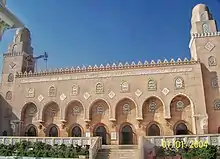
On the occasion of his 100th birth anniversary, Mohammed Burhanuddin established a third campus of the institute of Aljamea-tus-Saifiyah in Nairobi, Kenya.[35] Two years later, his son Mufaddal Saifuddin, announced the dedication of yet another campus of Aljamea-tus-Saifiyah in Marol (Mumbai) on his behalf. The construction of each campus is centered around a masjid, with all buildings oriented towards the Holy Kaaba in Mecca.[36] All four campuses have integrated green building techniques and observe environmental friendly operations. The buildings have been designed to utilize sunlight and facilitate natural ventilation as much as possible, and avoid dependency on artificial methods that consume great amounts of electricity, for e.g. solar water heating systems have been used in the dormitories of the Surat campus. A layout of coconut trees planted along the perimeter of the Karachi campus’ sports field mitigates waterlogging not only in Jamea but also in the surrounding homes. Recycling, compost facilities, motion sensor lighting and paper reduction policies are also applied in all four campuses.
Al-Multaqa al-Fatemi al-Ilmi
In the year 1978, Burhanuddin held a historic Islamic conference in Surat where he called upon delegates of the community centers to adhere to the time-tested traditions of their faith while also embracing the beneficial ‘new’ with the advent of scientific advancements. Amongst his important messages to the community was to renounce the practice of riba (lit. 'interest and usury'). The congregation initially started in Surat and was thereafter held in Mumbai, Karachi, Nairobi and Dar es salaam between 1978 - 1988.
The first gathering at Surat in 1978 was held in Iwaan al-Barakat (lit. 'Hall of Blessings') of Aljamea-tus-Saifiyah. Burhanuddin laid down seven principles in this meet to develop social, educational and economic fervor amongst his followers.
In 1984, on the twin occasions of the 100th birth anniversary of his father, Taher Saifuddin and the 1400th birth anniversary of Husayn ibn Ali, Muhammed’s grandson; Burhanuddin laid down another set of principles similar in spirit to the ones established before with the added emphasis of Qardan Hasana (lit. 'good loan'), which are interest-free loans. The abolition of riba from an institutional level and to certain extents on an individual level is considered to be the highlight of these meetings.[37]
Community Kitchens
Burhanuddin is credited with the establishment of community kitchens to provide meals everyday to the Dawoodi Bohra families, thus providing free time for women to pursue economic, educational or religious activities.[38] The community kitchens don't discriminate between the privileged and the underprivileged sections, both getting the same "good quality and hygienically-prepared" food,[39] while the community members have the provision of paying for their own family, and for sponsoring those who cannot afford it.[40]
Medical aid

Saifee Hospital
Burhanuddin conceptualized and established Saifee Hospital in Mumbai, a state-of-the-art, multi-specialty, 250-bed hospital.[41] It was inaugurated in 2005 by Dr. Manmohan Singh, the erstwhile prime minister of India.[42] During the inauguration, Dr Singh said: “The Bohra community has made a noble and significant contribution to society at large in constructing the Saifee Hospital and I too pray and hope that it benefits all sections of our society” [43]
The main vision of the hospital is to provide preventive, curative and holistic care to individuals from every strata. The hospital consists of 2574 beds and is a multi-speciality healthcare destination.[44] It has 44 ICU beds, 9 Operational Theatres and conducts approximately 10,000 surgeries in a year.[45] It has been certified by ‘The International Standards Organisation’ (ISO) and National Accreditation Board for Testing and Calibration Laboratories (NABL).[45]
The hospital specializes in Robotic Surgeries, Bariatric Surgeries, Cardiology, Critical Care Medicine and Dentistry among other services.[45]
Burhani Medical Idara
Mohammed Burhanuddin set up the Burhani Medical Idara (Department). The aim of this department is to provide medical aid to the members of the Dawoodi Bohra community.[46]
The official website of the department has an online Doctor’s directory which enlists the name of all doctors of the community who are providing their services free of charge. As of December 15 2019, a total of 2549 doctors have been registered with the department. The ratio of doctors with respect to the total members of the community is 1:300.[46]
Apart from this, hospitals have been established all across the globe in places such as Tanzania, Pakistan,etc where medical aid is provided at a subsidised rate.
Saifee Ambulance in Mumbai provides subsidised medical services to the local neighbourhood. It extends help in hospitalisation, immunisation and blood donation. It also sets up regular medical camps.[47]
Saifee Burhani Upliftment Trust
One of Burhanuddin’s major undertakings was the establishment of the Saifee Burhani Upliftment Trust. This redevelopment project comprising 16.5 acres of landform has approximately 250 existing buildings, 1250 shops and 3200 families under its radar in South Mumbai. The idea is to incorporate the locality’s dilapidated structures into a more sustainable development project, with new buildings, modern infrastructure, wider roads, more open spaces and commercial establishments.
Using the ‘best principles of urban planning’ the project aims to meet the present and future socio-economic needs of the people. The neighborhood, famously known as Bhendi Bazaar has been divided into 7 sub-clusters. The majority of the flats in these buildings will relocate the existing tenants/occupants to better accommodation. The area will have its own environment-friendly decorum along with an efficient sewage treatment plant, solar panels, rainwater harvesting, and garbage disposal units. The project aims to be resource neutral. It has already been pre-certified 'Gold' by the Indian Green Buildings Council.[48]
Memorisation of the Quran
Burhanuddin emphasized on the notion of ‘memorising the entire Holy Quran’. There are several examples where Burhanuddin has announced this idea on an international level, for example on the occasion of completion of 1400 years of Quranic revelation on Mohammed (1387 H), and in the International Islamic Conference on Aspects of Islamic Studies at Albert Hall, London (Meherjaan al-Alami al Islami 1976 CE) he addressed this desire in his speech.[49] Subsequently, in that same year, a Quranic institute by the name of Mahad al-Zahra was established by him.[50] The main objectives of this institution is to facilitate learning of the art of recitation, memorization and understanding of the Quran and its sciences.[51]
Mohammed Burhanuddin had inaugurated Mahad al-Zahra, Karachi in the year 1404H, during his birthday celebrations there. In 1415 H, he delivered a sermon where he stressed upon the memorisation of the Quran and directed the students of Aljamea-tus-Saifiyah to commit the entire Quran to memory. In the following year 1416 H, Husain Burhanuddin, the grandson of Mohammed Burhanuddin memorised the entire Quran and since then this initiative has taken traction tenfold.
In the year 1418 H/ 1998, Burhanuddin laid down the foundation for a new branch of Mahad al-Zahra in Surat (India).[52] The new facility provides the ideal environment of comfort and peace for the students engrossed in the demanding memorisation process. This institute also houses an audio studio where various recordings have been taped. The entire Quran has also been recorded and distributed via CDs and lately, through the internet. Students of Aljamea-tus-Saifiyah memorise the Quran under this institution and render teaching services to community members residing in different parts of the world. In H 1433 / C.E. 2013, a kindergarten named Rawdat al-Quran al-Kareem (RQK) was established in Mumbai with the aim of nurturing young pupils in the light of the Quran.[52]
E-learning
In the year 2005, a distance-learning memorization program was launched to reach out to members of the community who live in distant cities such as Sydney, Australia, Los Angeles. etc.
Marriage ceremonies
Burhanuddin continued his father’s tradition of organising mass marriages of community couples on his visits to different cities. Popularly known as ‘Rasme Saifee’ (alluding towards Saifuddin), it is essentially a mass marriage ceremony where the nikah of a large number of Dawoodi Bohra couples is solemnized simultaneously in accordance with the tenets of Islam. A worldwide committee known as ‘Taiseer un Nikah’ (facilitation of marriage) plays a leading role in match-making, counselling and facilitating the solemnization of marriages.[53]
Teachings
Ashara Mubaraka
Ashara Mubaraka (Arabic: عشرة مباركه, lit. 'the blessed ten') is an annual mourning of Husayn ibn Ali's martyrdom at Battle of Karbala.[54][55] In the tradition of the Fatimids,[56][57] the Da'i al-Mutlaq delivers ten wa'az (Persian: وعظ, lit. 'sermons') on Islamic philosophy, history, liturgy, expository, horatory over 9 days: One wa'az each day for 8 days starting 2nd Muharram and two on the final day of Ashura (Urdu: عاشوراء), the 10th of Muharram.[54] Every year the Da'i al-Mutlaq selects a city to host the Ashara at[55][58][59] which, at times, attract 100,000 to 200,000 azadar-e Husayn (Urdu: عزادارِ حسين, lit. 'mourners of Husayn').[60][61][62][63][64] The ashara wa'az from the host city is, on occasion, broadcast to various venues around the world.[60][61] Arrangements are made to provide the travelling pilgrims with free accommodation, transportation, and meals.[61][65][66][67] Elaborate Tazyeen (lit. 'decor') of the host venue is undertaken by faculty and members of Funun al-Quran, a department of Aljamea-tus-Saifiyah.[68]
| City | Country | Cont | CE | AH | Start Date | End Date |
|---|---|---|---|---|---|---|
1960s[2]:130 | ||||||
| Mumbai (1) | Asia | 1966 | 1386 | 23 December | 31 December | |
| Mumbai (2) | Asia | 1967 | 1387 | 23 December | 31 December | |
| Mumbai (3) | Asia | 1968 | 1388 | 23 December | 31 December | |
| Mecca (1) | Asia | 1969 | 1389 | 23 December | 31 December | |
1970s[2]:130 | ||||||
| Colombo (1) | Asia | 1970 | 1390 | 23 December | 31 December | |
| Calcutta (1) | Asia | 1971 | 1391 | 23 December | 31 December | |
| Surat (1) | Asia | 1972 | 1392 | 23 December | 31 December | |
| Mumbai (4) | Asia | 1973 | 1393 | 23 December | 31 December | |
| Mumbai (5) | Asia | 1974 | 1394 | 23 December | 31 December | |
| Mumbai (6) | Asia | 1975 | 1395 | 23 December | 31 December | |
| Calcutta (2) | Asia | 1976 | 1396 | 23 December | 31 December | |
| Chennai (1) | Asia | 1976 | 1397 | 23 December | 31 December | |
| Karachi (1) | Asia | 1977 | 1398 | 12 December | 20 December | |
| Jamnagar (1) | Asia | 1978 | 1399 | 5 November | 13 November | |
| Mumbai (7) | Asia | 1979 | 1400 | 5 November | 13 November | |
1980s[2]:130 | ||||||
| Cairo (1) | Africa | 1980 | 1401 | 5 November | 13 November | |
| Cairo (2) | Africa | 1981 | 1402 | 5 November | 13 November | |
| Sidhpur (1) | Asia | 1982 | 1403 | 5 November | 13 November | |
| Karachi (2) | Asia | 1983 | 1404 | 5 November | 13 November | |
| Nairobi (1) | Africa | 1984 | 1405 | 5 November | 13 November | |
| Surat (2) | Asia | 1985 | 1406 | 5 November | 13 November | |
| Indore (1) | Asia | 1986 | 1407 | 5 November | 13 November | |
| Karachi (3) | Asia | 1987 | 1408 | 5 November | 13 November | |
| Mumbai (8) | Asia | 1988 | 1409 | 5 November | 13 November | |
| Surat (3) | Asia | 1989 | 1410 | 5 November | 13 November | |
1990s[2]:130 | ||||||
| Dar es Salaam (1) | Africa | 1990 | 1411 | 5 November | 13 November | |
| Colombo (2) | Asia | 1991 | 1412 | 5 November | 13 November | |
| Pune (1) | Asia | 1992 | 1413 | 5 November | 13 November | |
| Mombasa (1) | Africa | 1993 | 1414 | 5 November | 13 November | |
| Mumbai (9) | Asia | 1994 | 1415 | 5 November | 13 November | |
| Mombasa (2) | Africa | 1995 | 1416 | 5 November | 13 November | |
| Karachi (4) | Asia | 1996 | 1417 | 5 November | 13 November | |
| Surat (4) | Asia | 1997 | 1418 | 5 November | 13 November | |
| Nairobi (2) | Africa | 1998 | 1419 | 5 November | 13 November | |
| Colombo (3) | Asia | 1999 | 1420 | 5 November | 13 November | |
2000s | ||||||
| Surat[2]:130 (5) | Asia | 2000 | 1421 | 5 November | 13 November | |
| Houston[69][70] (1) | North America | 2001 | 1422 | 5 November | 13 November | |
| Indore[55][63] (2) | Asia | 2002 | 1423 | 5 November | 13 November | |
| Mumbai[67] (10) | Asia | 2003 | 1424 | 5 November | 13 November | |
| Dubai[71] (1) | Asia | 2004 | 1425 | 5 November | 13 November | |
| Surat[72] (6) | Asia | 2005 | 1426 | 5 November | 13 November | |
| Mumbai[73] (11) | Asia | 2006 | 1427 | 5 November | 13 November | |
| Colombo[74][75] (4) | Asia | 2007 | 1428 | 5 November | 13 November | |
| Colombo[76][75] (5) | Asia | 2008 | 1429 | 5 November | 13 November | |
| Mombasa[77][78] (3) | Africa | 2008/09 | 1430 | 5 November | 13 November | |
| Marol[60] (1) | Asia | 2009 | 1431 | 18 December | 26 December | |
2010s | ||||||
| Mumbai[79] (12) | Asia | 2010 | 1432 | 8 December | 16 December | |
| Mumbai[lower-alpha 1] (13) | Asia | 2011 | 1433 | 27 November | 5 December | |
| Surat[lower-alpha 2][82] (7) | Asia | 2012 | 1434 | 15 November | 23 November | |
| Mumbai[lower-alpha 3] (14) | Asia | 2013 | 1435 | 5 November | 13 November | |
Patriotism
Mohammed Burhaunndin always instructed his followers to be patriotic to the state they resided in. In Islam, loyalty to the land of abode is an integral part of one’s faith. Mohammed Burhanuddin urged his followers to follow the laws of the country they live in and strive to be good citizens. Dawoodi Bohras have therefore become well integrated into the various societies that they have become part of, in the countries in which they reside. They are active in community help efforts and also partake in social drives and campaigns.
Islamic Identity

Throughout his 50 years in the office, Mohammed Burhaunndin strove to imbibe a particular Islamic identity to his followers. The most prominent distinction of the Dawoodi Bohra community is their religious attire, known as the Libas-al-Anwar (lit. Radiant Clothes.) For men, it usually consists of a trouser-like pant called an izar, coupled with a loose elongated shirt-like draping over the upper body --- called a kurta along with an overcoat called a saya, which is topped off by a skull cap called - Topi. The women’s attire is called a ‘Rida’ which is an all-covering dress worn by Bohra women. Furthermore, the men in the community adorn a full-grown beard which adds to their distinctive identity.
In addition to the distinctive clothes, he also urged his followers to speak a unique language, known as the Lisan-al-Da’wah (the language of Da’wah). The language is predominantly rooted in Arabic and Gujarati with a mix of words from other languages such as Urdu and Persian.
Burhanuddin has also supported the movement towards Islamic English where the expression of Islamic norms and Quranic concepts are better articulated in the English language without compromising the meaning. For example ‘Mosque’ though derived from the Arabic word ‘Masjid’ fails to convey the original meaning of the word, ‘a place for prostration or sajda.[83]
Upliftment
During his life, Mohammed Burhanuddin regularly urged his followers to extend help to the less fortunate in society. In the year H 1424 H/ C.E. 2002, during his visit to the island nation of Madagascar, Burhanuddin instituted the idea of ‘upliftment’ and called upon all the members of the community to help their fellow community members. Along with the community members, he expanded his efforts to help the society at large. This can be understood by the aids provided by him in the aftermath of the Bombay Riots and the Bhuj earthquake.
During the Holy Month of Ramadan, the less fortunate members of the community would be provided essentials such as clothes, food, shelter and medical services.
To carry out these functions, Mohammed Burhanuddin set up institutions such as His Holiness Doctor Syedna Taher Saifuddin Memorial Foundation (STSMF).[84]
Trade and business
The new Trust was aimed to provide modern solutions for today's modern business. Throughout his life, Mohammed Burhanuddin urged his community to enter the world of trade, business and industrialization. The word ‘Bohra’ itself denotes the meaning of ‘a trader.’. Mohammed Burhanuddin encouraged his followers to move forward and expand their businesses. He stressed to his followers to keep the tradition of business and entrepreneurship intact in the community. To help his followers to that extent, Mohammed Burhanuddin institutionalized the concept of Islamic Loans which are interest free, known as Qardan Hasanah (Good Loans). In 1991, Mohammed Burhanuddin established the Burhani Qardan Hasana Trust. The main goal of this trust is to provide interest free loans to community members to fulfill their economic goals and help expand their businesses. Furthermore, to help enhance his community members' business skills, Mohammed Burhanuddin set up the Burhaniyah Business Counseling Centre (BBCC) in Mumbai. The center organized numerous expos named Burhani Expo to help connect community members with each other to expand their businesses and create a global network of traders within the community.
In 2014, Mohammed Burhanuddin again re-institutionalized this concept by renaming the Qardan Hasnah trust by the name of Hasanaat al Qardan Hasan al Burhaniyah.[85] The BBCC was also absorbed by this new trust and a new department was formed to help community members prosper in their business endeavors. This department was named ‘Tijarat Rabeha’ which translates into Profitable Business. The main aim of this department is to facilitate the needs of new and upcoming entrepreneurs within the community by providing modern day solutions and ideas to them. It also organizes numerous seminars, workshops and webinars to help existing businessmen within the community expand their businesses and evolve their business acumen in course with the ever changing times.[86]
Welfare of women
Burhanuddin formed the Amatullah Aaisaheba Memorial Trust in 1996 in memory of his late wife, Amatullah Aai who had played a leading role in the welfare of the Dawoodi Bohra women. The trust lays particular emphasis on the support of home industries run by women.[87]
Housing complexes
The community facilitates schemes to provide flats and houses at cheaper rates. Several housing complexes have been established all over India, for example in Kalyan, Marol and even in foreign countries such as in Nairobi, Kenya.[88]
In H 1426 / C.E. 2004, a department known as Faiz Enayat Amakene Anwar was established in Mumbai. The main aim of this department is to provide better living conditions for those living in poor conditions.[89]
Awards and honors
- "Order of the Star of Jordan", the highest civic honor of Jordan by the King of Jordan.[90]
- "Order of the Nile", the highest civilian honor of Egypt.[91]
- "Honorary Doctorates", by Al-Azhar University, Egypt, Aligarh Muslim University, India and University of Karachi, Pakistan.[92]
- On 6 March 2011, Burhani Foundation, India made largest distribution of bird feeders (20,631) to celebrate Mohammed Burhanuddin 100th birthday (according to the Islamic calendar). It was recorded in Guinness World Records.[93][94]
- Padma Shri, the fourth highest civilian award of India, in 2015.[95]
- Mohammed Burhanuddin was named one of The 500 Most Influential Muslims in the years 2009, 2010, 2011, 2012 & 2013.[96]
Death
Burhanuddin died of cardiac arrest at his home Saifee Mahal in Mumbai on 17 January 2014.[90] The Bohra community announced a 40-day mourning period in respect of the departed leader.[97] His second son and successor, Mufaddal Saifuddin led the Salat al-Janazah (lit. 'funeral procession') of his father at Gurrat al-Masajid, after which he was buried at Raudat Tahera besides his father Taher Saifuddin.[92] The Indian flag was flown at half-mast as a mark of state mourning.[92]
The day after his demise, a crowd of supporters peacefully assembled outside his residence to pay their respects; Unfortunately, when the gates were opened to let them in, a human stampede ensued, killing eighteen people.[98] A commemoration service held one year after Burhanuddin's death drew an estimated three hundred thousand bohras to Mumbai; two dedicated townships were built specially to accommodate them.[99]
Succession
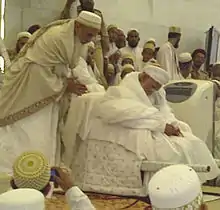
Mohammed Burhanuddin, died in January 2014.[100] As per the tenets of the sect[101] each predecessor is required to nominate his successor during his lifetime.[102][103] His death sparked a succession crisis where two rival claimants emerged for the title of 53rd Dā'ī al-Mutlaq:[104] his son, Mufaddal Saifuddin, and his half-brother, Khuzaima Qutbuddin, who was previously Mazoon [105] of the Dawoodi Bohra.[106]
The challenge created a divide in the community with the vast majority aligning with Mufaddal Saifuddin[107][108] whilst a small number aligned with Khuzaima Qutbuddin.[109] Mufaddal Saifuddin assumed control of the Dawoodi Bohra administration and infrastructure. He is largely accepted as the Bohras' leader[110] by governments and other public bodies.[111] The UK Charity Commission[112] has stated in writing, that "our view is that His Holiness Syedna Mufaddal Saifuddin is the current incumbent of the office of Dai al-Mutlaq."[113]
Genealogy
Burhanuddin is a descendant of leaders of the early Fatimid mission in India, Fakhr al-Din Shaheed, Abd al-Qadir Hakim al-din, Khanji Pheer, and Syedi Lukman.[114]
Notable works
Rasāʾil Ramaḍāniyya (Epistles)
The following are a list of Rasāʾil Ramaḍāniyya composed by Mohammed Burhanuddin. Each Risalah is given a title according to Abjad numerals equivalent to the Hijri year of its publication:[115][116]
| ID | Title | Title (English) | Hijri | Pub. | Year |
|---|---|---|---|---|---|
| SMB 00 | حكمة الغيبة الحقيقية | Hikmat al-Ghaybah al-Haqiqiyyah | 1385H | ||
| SMB 01 | استفتاح زبد المعارف | Isteftah Zubad al-Ma'arif | 1385H | 1386H | |
| SMB 02 | فيوضات الجنة | Fuyoodhaat al-Jannah | 1386H | ||
| SMB 03 | سلام نضرة النعيم | Salaam Nadrah al-Na'eem | 1387H | ||
| SMB 04 | ذات النور | Zaat al-Noor | 1388H | ||
| SMB 05 | ظهور مجد الفاطميين | Zuhoor Majd al-Fatimiyeen | 1389H | ||
| SMB 06 | بركة صبغة الله | Barakah Sibghah Allah | 1390H | ||
| SMB 07 | نشر الخير [117] | Nashr al-Khayr | 1391H | 1437H | 2017 |
| SMB 08 | ندى الفيوضات [118] | Nadā al-Fūyūdāt | 1392H | 1438H | 2018 |
| SMB 09 | سلسبيل روض القدس [119] | Salsabīl Rawd al-Quds | 1392H | 1439H | 2019 |
Notes
References
- Yumn Mansoor al Yemen – via mahadalquran.com.
- Abdulhussein, Mustafa (1 February 2001). Al-Dai Al-Fatimi Syedna Mohammed Burhanuddin: An Illustrated Biography. Aljamea-tus-Saifiyah Trust. ISBN 978-0953625604 – via books.google.com.
- Wajihuddin, Mohammed (18 January 2014). "Syedna, Dawoodi Bohras' spiritual leader". The Times of India. Mumbai. Archived from the original on 3 April 2018.
- "Spiritual Leader Syedna Mohammed Burhanuddin Dead". Newswire. Outlook India. 17 January 2014. Archived from the original on 13 June 2020.
- Raghib, Qureish (15 February 2014). "Syedna Burhanuddin". Milli Gazette. Archived from the original on 19 June 2020.
- Blank, Jonah (2001). Mullahs on the Mainframe: Islam and Modernity Among the Daudi Bohras. University of Chicago Press. pp. 184–185. ISBN 0226056775.
- "India PM's Conference on Islamic Heritage addressed by King of Jordan". thedawoodibohras.com. 1 March 2018. Archived from the original on 11 June 2020. Retrieved 11 June 2020.
- Khan, Akhtar (17 December 2011). "कल गलियाकोट आएंगे डा. सैयदना साहब" [Dr. Syedna Saheb to visit Galiyakot tomorrow]. udaipurpost.com (in Hindi). Archived from the original on 19 June 2020.
- "Know 10 rare facts about Dawoodi Bohra leader Syedna Mohammed Burhanuddin". Archived from the original on 7 January 2018. Retrieved 7 April 2014.
- Mohiyuddin, Hozefa (2011). Tasbeeh al Mafakhir [Praiseworthy Feats]. Neelam Publication – via misbah.info.
- "Syedna Mohammed Burhanuddin: A symbol of piety, peace for Dawoodi Bohras". The Hindu. Mumbai. 17 January 2014. Retrieved 7 April 2014.
- Madan, Karuna (17 January 2014). "Syedna Mohammad Burhanuddin in profile". Gulf News. New Delhi. OCLC 232115522. Archived from the original on 19 June 2020.
- Bohra, Mansoor Ali (17 January 2014). "Dr. Sayyedna Mohammed Burhanuddin (A.Q.) passes away". udaipurtimes.com. Archived from the original on 19 June 2020.
- Najmuddin, Yusuf (2000). 52nd El-Dai-El-Fatimi: 75 Momentous Years in Retrospect. Jamiah al-Sayfiyah.
- "Bohras pray for their leader". Mumbai Mirror. 26 March 2011. Archived from the original on 21 June 2020.
- A Golden Panorama: Life and Work of His Holiness Dr. Syedna Taher Saifuddin. 1965. p. 34.
- A Treasury of Reminiscences: His Holiness Dr. Syedna Mohammed Burhanuddin. 1966. p. 70.
- Wajihuddin, Mohammed (18 January 2014). "Syedna, Dawoodi Bohras' spiritual leader, dies at 102". Times of India. Archived from the original on 27 January 2021. Retrieved 26 January 2021.
- Shakir, Joher (March 2010). "Tareekh Ek Sunehary Sadi Ni". Badre Muneer. Vol. 15 no. 8.
- "Celebrating 100 years of unparalleled leadership". mid-day. 25 March 2011.
- http://www.sbut.com/tasees-performed-by-aqa-maula.html. Missing or empty
|title=(help) - Correspondent, dna (6 June 2011). "Successor to Syedna Mohammed Burhanuddin named". DNA India.
- https://www.youtube.com/watch?v=Ge9wG2Irv-Q. Missing or empty
|title=(help) - El Barbary, Mohamed; Al Tohamy, Aisha; Ali, Ehab (1 February 2017). "Shiite Connotations on Islamic Artifacts from the Fatimid period (358-567 A.H/ 969-1171 A.D) Preserved in the Museum of Islamic Art in Cairo". International Journal of Heritage, Tourism and Hospitality. 11 (3 (Special Issue)): 121–137. doi:10.21608/ijhth.2017.30225. ISSN 2636-414X.
- "Signposts". India Today. 18 October 1999. Retrieved 7 April 2014.
- Khurana, Ashlesha (6 November 2009). "From Gurukul to IBO varsity". The Times of India. Retrieved 7 April 2014.
- "Know 10 rare facts about Dawoodi Bohra leader Syedna Mohammed Burhanuddin". India TV. 12 February 2014. p. 6. Retrieved 7 April 2014.
- A Golden Era. Mumbai, India: Department of Statistics and Information, Dawat-e-Hadiyah. 2016. p. 20.
- "Education". 5 February 2018. Archived from the original on 23 June 2020. Retrieved 20 May 2020 – via thedawoodibohras.com.
- "Council for the Indian School Certificate Examinations: List of Affiliated Schools". dise.in. Archived from the original (PDF) on 23 June 2020. Retrieved 23 June 2020.
- "Muntalaq Islami". msbhaidery.com. Archived from the original on 29 June 2020. Retrieved 25 June 2020.
- "About MSB". idaramsb.net. Archived from the original on 23 June 2020. Retrieved 23 June 2020.
- "Bohra spiritual head visits MSB Educational Institute". timesofindia.com. Times of India. 2 February 2011. Archived from the original on 23 June 2020.
- "Idara | MSB". Retrieved 8 November 2020.
- "Nairobi Campus". Aljamea-tus-Saifiyah.
- "Campuses". Aljamea-tus-Saifiyah.
- His Holiness, Syedna Aali Qadr Mufaddal Saifuddin Saheb (1439H). ملتقى سفينة البركات. Mumbai, India: Badri Mahal.
- Subramanian, Reetika (16 September 2011). "City Bohris start dabba service for community households". Hindustan Times. Mumbai. Retrieved 11 July 2015.
- Ansari, Shabana (9 March 2012). "Bohra women get respite from cooking". DNA. Mumbai. Retrieved 7 July 2015.
- Diggikar, Ranjana (5 July 2015). "Freedom from the kitchen smoke & heat". The Times of India. Aurangabad. Retrieved 7 July 2015.
- "saifee hospital mumbai". Best Hospitals in India Low Cost Treatment | Cost Treatment in India at Best Hospitals.
- "Indian Prime Minister inaugurates Saifee Hospital in Mumbai". wam.
- Al-Dai al-Fatimi, Syedna Mohammed Burhanuddin : an illustrated biography. London: Al-Jamea-Tus-Saifiyah. 2001. ISBN 0-9536256-0-5. OCLC 45854075.
- "Saifee Hospital Mumbai: multi-speciality, professional healthcare". www.saifeehospital.com. Retrieved 8 November 2020.
- Feb 28, SPOTLIGHT |; 2020; Ist, 13:23. "https://timesofindia.indiatimes.com/articles/saifee-hospital-the-centre-for-world-class-healthcare-facilities/articleshow/74380775.cms?from=mdr". The Times of India. Retrieved 8 November 2020. External link in
|title=(help)CS1 maint: numeric names: authors list (link) - "About Us | BMI". www.burhanimedicalidara.org. Retrieved 8 November 2020.
- Al-Dai al-Fatimi, Syedna Mohammed Burhanuddin : an illustrated biography. London: Al-Jamea-Tus-Saifiyah. 2001. ISBN 0-9536256-0-5. OCLC 45854075.
- India, Press Trust of (13 May 2018). "Saifee Burhani Upliftment Trust holds march on old buildings". Business Standard India.
- Saifuddin, Mufaddal. رسالة النعي المسماة - حكمة الغيبة القدسانية الابدية. Mumbai, India.
- Dawat e Hadiyah. A Golden Era. Mumbai: Department of Statistics and Information.
- "من مقالة سيدي حسين بهائي صاحب برهان الدين ادام الله علو مجده". Mahad al-Zahra (in Arabic). 12 August 2020. Retrieved 12 November 2020.
- Saifuddin, Mufaddal (1438). جامعة ثمرات العلوم. Mumbai: Badri Mahal.
- islamicvoice.com https://islamicvoice.com/September2006/Culture&Traditions/. Retrieved 12 November 2020. Missing or empty
|title=(help) - "Ashara Mubaraka: A Journey Towards Humanity". thedawoodibohras.com. Archived from the original on 1 June 2020. Retrieved 17 June 2020.
- Mahajan, Neeraj (ed.). "Modi & Imam Husain's sacrifice". taazakhabarnews.com. Indore. Archived from the original on 19 June 2020. Retrieved 22 June 2010.
- Sanders, Paula (1994). "Ceremonial as Polemic". Ritual, Politics, and the City in Fatimid Cairo. SUNY. p. 125. ISBN 9780791417812 – via books.google.com.
- Walker, Paul Ernest (2009). الخطب الفاطمية [Sermons of the Fatimids] (in Arabic). I.B Tauris. ISBN 9781845119911 – via books.google.com.
- "In a first, 35,000 Dawoodi Bohras observe Muharram in Chennai". The Times of India. Chennai. 10 September 2020. Archived from the original on 20 June 2020.
- Muiz, Sarah (10 September 2020). "Ashara mubaraka in all its glory". dailymirror.lk. The Daily Mirror Sri Lanka. Wijeya Newspapers. Archived from the original on 22 June 2020.
- "100,000 Dawoodi Bohras in Mumbai for discourses by Syedna". Indo-Asian News Service. 22 December 2009. Archived from the original on 17 June 2020 – via twocircles.net.
- "200,000 Dawoodi Bohras attend Mumbai's Moharram discourses". The New Indian Express. Indo-Asian News Service. 13 November 2013. Archived from the original on 17 June 2020.
Nearly 200,000 Dawoodi Bohras from all over the world attended the 10-day Moharram observance which culminated here Wednesday as Ashura, under the guidance of their 102-year-old spiritual head Syedna Mohammed Burhanuddin...Elaborate arrangements for lodging, boarding, transportation, medical and other requirements of the visitors were made...For the benefit of the global community members, the discourses were relayed live via internet to over 650 community centres.
- Saiyed, Kamal (30 October 2014). "Dawoodi Bohra head praises PM Modi in Muharaam speech". The New Indian Express. Archived from the original on 17 June 2020.
- Shelar, Jyoti (25 August 2018). "Dawoodi Bohras to flock to Indore for Syedna's Muharram sermons". The Hindu. Archived from the original on 17 June 2020.
- Najmi, Quaid (14 December 2010). "Thousands Weep as Bohra Chief, 99, Conducts Moharram Discourse". Indo-Asian News Service. Archived from the original on 17 June 2020 – via daijiworld.com.
- De Alwis, Nathasha (6 September 2019). "Annual congregation of Dawoodi Bohra Community in Sri Lanka". newsfirst.lk. Archived from the original on 17 June 2020.
Community members in Colombo have opened their homes to foreign guests, many of whom they’ve never met before. Bus companies have been hired to ferry attendees from different parts of the city. Over the course of the nine days, hundreds of thousands of meals will be served.
- Shelar, Jyoti (6 September 2016). "A journey of faith". The Times of India. Archived from the original on 17 June 2020.
Syedna holds the waaz at different venues every year with the Bohra jamiats or groups, from across the world, requesting him to select their city as the host. When they send their requests, it means that they are sure that they have the facilities to support the requirements of the gathering. This includes the local travel of visitors between their place of accommodation and the venue, and also their meals
- Farzana Contractor, ed. (25 August 2003). "Syedna At Saifee Masjid". Upper Crust India. Archived from the original on 19 June 2020 – via uppercrustindia.com.
- "Aljamea-tus-Saifiyah and the Radiant Arts Exhibition in Mumbai". jameasaifiyah.edu. Mumbai. 22 March 2018. Archived from the original on 28 June 2020.
- Hegstrom, Edward (9 March 2001). "Followers pay homage to Muslim leader". Houston Chronicle. Hearst Newspapers. ISSN 1074-7109. Archived from the original on 19 June 2020.
- "The Dawoodi Bohra Community of Houston". Archived from the original on 17 June 2020. Retrieved 18 June 2020.
The Dawoodi Bohra community sprouted in the greater Houston area in the 1950s. A few decades later, the community’s growth facilitated the construction of a masjid near the Katy Area, which was inaugurated in 2001 by the late Dr. Syedna Mohammed Burhanuddin (R.A.). The visit occurred during the days of Ashara Mubaraka – held sacred for the memorialization of the martyrdom of Prophet Mohammed’s grandson Imaam Hussain ibn Ali.
- "Syedna in Dubai". Milli Gazette. 5 (6) (100 ed.). Mumbai. 16 March 2004. ISSN 0972-3366. Archived from the original on 19 June 2020.
- "Community News". Milli Gazette. 6 (5) (123 ed.). Mumbai. 1 March 2005. ISSN 0972-3366. Archived from the original on 19 June 2020.
Bohra spiritual leader Syedna Burhanuddin delivering Muharram sermon at Surat on 17 February 2005
- Khan, Alifiya; Menon, Vinod Kumar (17 December 2009). "NRIs happily pay Rs 5,000 a day to stay in shanty". midday.com. Mumbai: Mid Day. Archived from the original on 19 June 2020.
2006: The last time the sermon was held in Mumbai.
- Mushtaq, Munza (16 January 2007). "International Bohra leader arrives in Sri Lanka". Asian Tribune. Colombo. Archived from the original on 18 June 2020.
- Yusuf Mamujee (2017). "The Dawoodi Bohras of Sri Lanka". In S. Pathmanathan; B. A. Hussainmiya; Malani Endagama; Vajira Narampanawa; Kalinga Tudor Silva (eds.). People of Sri Lanka (PDF). Ministry of National Coexistence, Dialogue and Official Languages, Government of Sri Lanka. p. 295. ISBN 9789557537030. Archived from the original (PDF) on 18 June 2020 – via reliefweb.int.
- Perer, Quintus (13 January 2008). "Given the present situation, travel industry satisfactory". Asian Tribune. Colombo. Archived from the original on 18 June 2020.
- Mwakio, Philip (5 January 2009). "Community marks festivities in Mombasa". standardmedia.co.ke. Kenya. Archived from the original on 19 June 2020.
- Qureish Raghib (31 December 2008). Kenya President Meets Syedna.
- Wajihuddin, Mohammed (14 December 2010). "Syedna's sermon draws 32,000 at Saifee mosque". The Times of India. Mumbai. Archived from the original on 18 June 2020.
- Abbas, Zaheer (6 December 2011). "[Photos] Ashura 2011: Udaipur Bohra commemorate Martyrdom of Imam Hussain". udaipurtimes.com. Udaipur. Archived from the original on 19 June 2020.
- "Dawoodi Bohras pour into Surat for big meet". The Indian Express. Surat. 13 November 2012. Archived from the original on 18 June 2020.
- "Dawoodi Bohra from world over congregate in Mumbai, observe Ashara Mubaraka in presence of HH Dr. Syedna Mohammed Burhanuddin". Indian Muslim Observer. 15 November 2013. Archived from the original on 18 June 2020.
- Al-Dai al-Fatimi, Syedna Mohammed Burhanuddin : an illustrated biography. London: Al-Jamea-Tus-Saifiyah. 2001. p. 28. ISBN 978-0953625604.
- Al-Dai al-Fatimi, Syedna Mohammed Burhanuddin : an illustrated biography. London: Al-Jamea-Tus-Saifiyah. 2001. p. 114. ISBN 978-0953625604.
- "About This Organization | Al-Tijarat Al-Raabehah".
- https://tijaaratraabehah.org/. Missing or empty
|title=(help) - Al-Dai al-Fatimi, Syedna Mohammed Burhanuddin : an illustrated biography. London: Al-Jamea-Tus-Saifiyah. 2001. p. 115. ISBN 978-0953625604.
- Al-Dai al-Fatimi, Syedna Mohammed Burhanuddin : an illustrated biography. London: Al-Jamea-Tus-Saifiyah. 2001. p. 118. ISBN 978-0953625604.
- Saifuddin, Dr. Syedna Mufaddal. رسالة النعي المسماة - حكمة الغيبة القدسانية الابدية. Mumbai: Badri Mahal.
- "Bohras protest Syedna's half-brother 's claim". The Times of India. Retrieved 26 March 2014.
- "Leader of Bohra community Dr Syedna Mohammed Burhanuddin dead at 102 - The Express Tribune". The Express Tribune. 17 January 2014.
- "Syedna Mohammed Burhanuddin laid to rest in Mumbai, 70,000+ mourners attend funeral". Retrieved 7 April 2014.
- "Largest distribution of bird feeders". Retrieved 7 April 2014.
- "Mohammed Dilawar's 'save sparrows' campaign enters Guinness record". Retrieved 7 April 2014.
- "Padma Awards 2015". Press Information Bureau. Archived from the original on 26 January 2015. Retrieved 25 January 2015.
- "The Muslim 500".
- "Dawoodi Bohra community spiritual head, Dr Burhanuddin passes away". Retrieved 7 April 2014.
- "Funeral stampede kills 18 in Indian city of Mumbai". BBC. 18 January 2014. Retrieved 12 June 2014.
- "Dawoodi Bohras observe late Syedna's death anniversary". DNA India. 5 January 2015.
- "Leader of Bohra community Dr Syedna Mohammed Burhanuddin dead at 102". The Express Tribune.
- Blank, Jonah (2001). Mullahs on the Mainframe : Islam and Modernity Among the Daudi Bohras. University of Chicago Press; 1 edition (15 April 2001). p. 135 & 165. ISBN 978-0-226-05676-0.
- Daftary, Farhad (2007). The Isma'ilis: Their History and Doctrines. Cambridge University Press. p. 275. ISBN 978-1-139-46578-6.
- Daftary, Farhad (2011). A Modern History of the Ismailis: Continuity and Change in a Muslim Community. I. B. Tauris. p. 333. ISBN 978-1-84511-717-7.
- Mawani, Rizwan (30 January 2014). "The Intricacies of Succession: Two Claimants Emerge for Dawoodi Bohra Leadership". HuffPost. Retrieved 11 February 2014.
- Blank, Jonah (2001). Mullahs on the Mainframe: Islam and Modernity Among the Daudi Bohras. The University of Chicago Press. p. 163. ISBN 0-226-05676-7.
- "Talk of rift among Bohras over Syedna's successor". Hindustan Times. 15 April 2013. Archived from the original on 26 March 2014.
- "Dawoodi Bohras stage a peace march".
- "Bohras make anti-Syedna faction's ex-communication official, stick by Mufaddal Saifuddin".
- ""Over 200 people attended the Mumbai 'misaaq'" - Breakaway Dawoodi Bohra faction alleges harassment".
- Gnostic, Ismaili (5 July 2014). "What is Shia Islam? A Visual Chart of Different Shia Communities". Ismaili Gnosis. Retrieved 15 June 2016.
- "500 muslims" (PDF). Archived from the original (PDF) on 4 April 2016.
- "The Charity Commission". Government of the United Kingdom. Retrieved 27 August 2016.
- Waring, Kate (15 August 2014). "UK Charity Commission's View regarding The Dawat-e-Hadiyah Trust". Herbert Smith Freehills Solicitors and Nabarro Solicitors (Charity Commission).
- Saifuddin, Aali Qadr Mufaddal (2016). رسالة النعي المسماة - حكمة الغيبة القدسانية الابدية [Hikmah al-Ghaybah al-Qudsāniyyah al-Abadiyyah] (in Arabic).
- ميزة مفتاح خزائن العلوم. Mumbai, India.: Aljamea-tus-Saifiyah, Badri Mahal.
- Traboulsi, Samer (2016). "Transmission of Knowledge and Book Preservation in the Ṭayyibī Ismāʿīlī Tradition". Intellectual History of the Islamicate World. 4 (1–2): 22–35. doi:10.1163/2212943X-00401004 – via Brill.
- His Holiness, Syedna Aali Qadr Mufaddal Saifuddin Saheb (1437H). نشر الخير (Nashr al-Khayr) 1391. His Holiness Syedna Aali Qadr Mufaddal Saifuddin Saheb, Badri Mahal, Mumbai, India.
- His Holiness, Syedna Aali Qadr Mufaddal Saifuddin Saheb (1438H). ندى الفيوضات ١٣٩٢. His Holiness Syedna Aali Qadr Mufaddal Saifuddin Saheb, Badri Mahal, Mumbai, India.
- His Holiness, Syedna Aali Qadr Mufaddal Saifuddin Saheb (1439H). سلسبيل روض القدر. Mumbai, India: Badri Mahal.
Further reading
- Abdulhussein, Mustafa (1 February 2001). Al-Dai Al-Fatimi Syedna Mohammed Burhanuddin: An Illustrated Biography. Aljamea-tus-Saifiyah Trust. ISBN 978-0953625604 – via books.google.com.
- Hassanally, Yusuf Mamujee (2017). Gems of History: A Brief History of Doat Mutlaqeen. Colombo: Alvazaratus Saifiyah.
- Najmuddin, Yusuf (1985). Fifty-Second El-Dai el-Fatimi: Seventy-Five Momentous Years in Retrospect. Bombay: Aljamea-tus-Saifiyah – via books.google.com.
- Esposito, John L, ed. (2009). "Muhammad Burhanuddin". Encyclopedia of the Modern Islamic World. Oxford University Press. ISBN 9780199861255. Archived from the original on 20 January 2015 – via archive.mumineen.org.CS1 maint: unfit URL (link)
- Mustafa, Shabbir Hussain (2011). "In Defense of the Community: Syedna Taher Saifuddin and Reassertion of Authority". Between Community and Securalism: The Dawoodi Bohras and Agendas of 'Reform' in India, c. 1915-1985 (Thesis). National University of Singapore. Archived from the original on 13 June 2020.
- Electricwala, Mohammed Abbas (2015). Intellectual upliftment through memorization of Quran: A social aspect. inflibnet.ac.in (Thesis). Shri Jagdishparasad Jhabarmal Tibrewala University. Archived from the original on 18 June 2020 – via shodhganga.inflibnet.ac.in.
| Shia Islam titles | ||
|---|---|---|
| Preceded by Taher Saifuddin |
52nd Dā'ī al-Mutlaq 1965-2014 |
Succeeded by Mufaddal Saifuddin |


